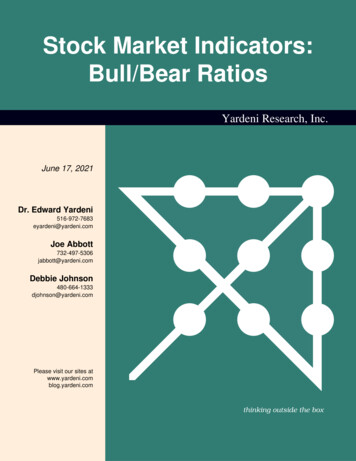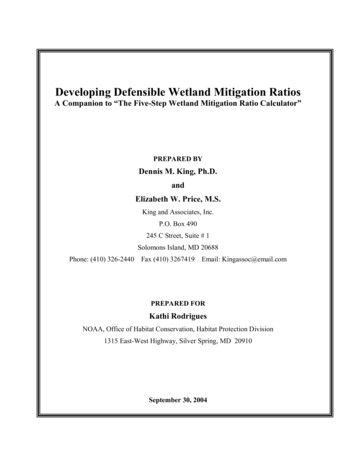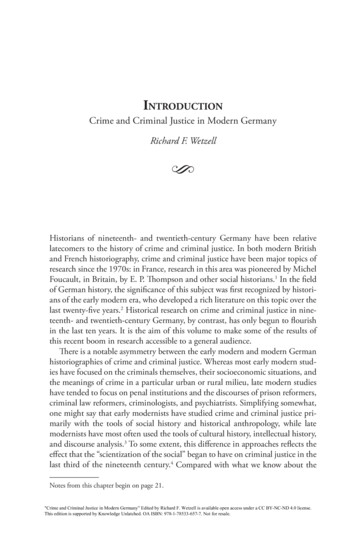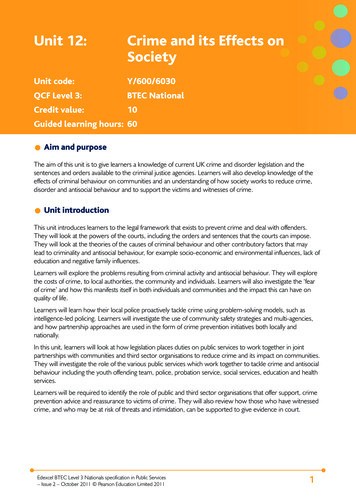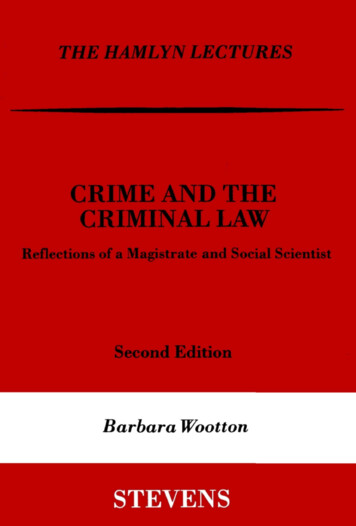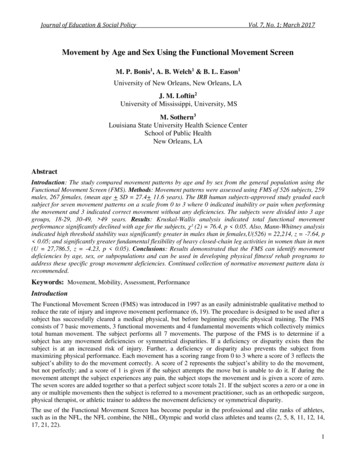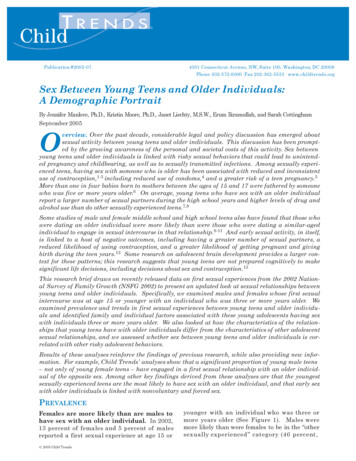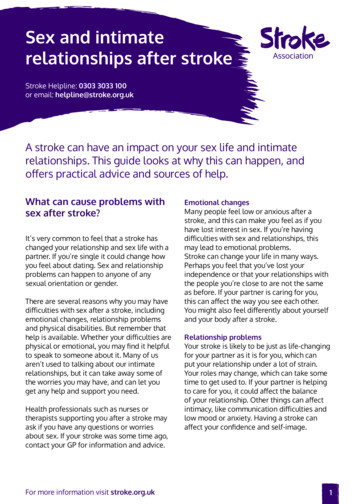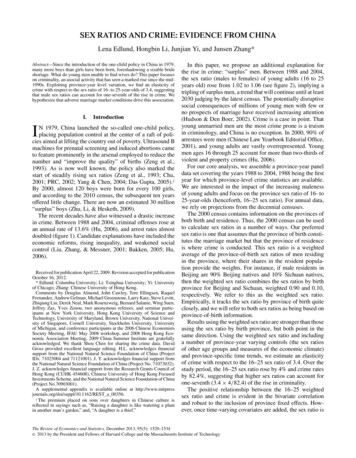
Transcription
SEX RATIOS AND CRIME: EVIDENCE FROM CHINALena Edlund, Hongbin Li, Junjian Yi, and Junsen Zhang*Abstract—Since the introduction of the one-child policy in China in 1979,many more boys than girls have been born, foreshadowing a sizable brideshortage. What do young men unable to find wives do? This paper focuseson criminality, an asocial activity that has seen a marked rise since the mid1990s. Exploiting province-year level variation, we find an elasticity ofcrime with respect to the sex ratio of 16- to 25-year-olds of 3.4, suggestingthat male sex ratios can account for one-seventh of the rise in crime. Wehypothesize that adverse marriage market conditions drive this association.I.IntroductionIN 1979, China launched the so-called one-child policy,placing population control at the center of a raft of policies aimed at lifting the country out of poverty. Ultrasound Bmachines for prenatal screening and induced abortions cameto feature prominently in the arsenal employed to reduce thenumber and “improve the quality” of births (Zeng et al.,1993). As is now well known, the policy also marked thestart of steadily rising sex ratios (Zeng et al., 1993; Chu,2001; PRC, 2002; Yang & Chen, 2004; Das Gupta, 2005).1By 2000, almost 120 boys were born for every 100 girls,and according to the 2010 census, the subsequent ten yearsoffered little change. There are now an estimated 30 million“surplus” boys (Zhu, Li, & Hesketh, 2009).The recent decades have also witnessed a drastic increasein crime. Between 1988 and 2004, criminal offenses rose atan annual rate of 13.6% (Hu, 2006), and arrest rates almostdoubled (figure 1). Candidate explanations have included theeconomic reforms, rising inequality, and weakened socialcontrol (Liu, Zhang, & Messner, 2001; Bakken, 2005; Hu,2006).Received for publication April 22, 2009. Revision accepted for publicationOctober 16, 2012.* Edlund: Columbia University; Li: Tsinghua University; Yi: Universityof Chicago; Zhang: Chinese University of Hong Kong.Comments by Douglas Almond, John Cawley, Tore Ellingsen, RaquelFernandez, Andrew Gelman, Michael Greenstone, Larry Katz, Steve Levitt,Zhiqiang Liu, Derek Neal, Mark Rosenzweig, Bernard Salanie, Wing Suen,Jeffrey Zax, Yves Zenou, two anonymous referees, and seminar participants at New York University, Hong Kong University of Science andTechnology, University of Maryland, Brown University, National University of Singapore, Cornell University, Stockholm University, Universityof Michigan, and conference participants at the 2006 Chinese EconomistsSociety Meeting, IFAU May 2008 workshop, and 2008 Hong Kong Economic Association Meeting, 2009 China Summer Institute are gratefullyacknowledged. We thank Shou Chen for sharing the crime data. DavidGross provided excellent language editing. H.L. acknowledges financialsupport from the National Natural Science Foundation of China (ProjectIDs: 71025004 and 71121001). J. Y. acknowledges financial support fromthe National Natural Science Foundation of China (Project No. 71073032).J. Z. acknowledges financial support from the Research Grants Council ofHong Kong (CUHK 454608), Chinese University of Hong Kong FocusedInvestments Scheme, and the National Natural Science Foundation of China(Project No.70903001).A supplemental appendix is available online at REST a 00356.1 The premium placed on sons over daughters in Chinese culture isreflected in sayings such as, “Raising a daughter is like watering a plantin another man’s garden,” and, “A daughter is a thief.”In this paper, we propose an additional explanation forthe rise in crime: “surplus” men. Between 1988 and 2004,the sex ratio (males to females) of young adults (16 to 25years old) rose from 1.02 to 1.06 (see figure 2), implying atripling of surplus men, a trend that will continue until at least2030 judging by the latest census. The potentially disruptivesocial consequences of millions of young men with few orno prospects of marriage have received increasing attention(Hudson & Den Boer, 2002). Crime is a case in point. Thatyoung unmarried men are the most crime prone is a truismin criminology, and China is no exception. In 2000, 90% ofarrestees were men (Chinese Law Yearbook Editorial Office,2001), and young adults are vastly overrepresented. Youngmen ages 16 through 25 account for more than two-thirds ofviolent and property crimes (Hu, 2006).For our core analysis, we assemble a province-year paneldata set covering the years 1988 to 2004, 1988 being the firstyear for which province-level crime statistics are available.We are interested in the impact of the increasing malenessof young adults and focus on the province sex ratio of 16- to25-year-olds (henceforth, 16–25 sex ratio). For annual data,we rely on projections from the decennial censuses.The 2000 census contains information on the provinces ofboth birth and residence. Thus, the 2000 census can be usedto calculate sex ratios in a number of ways. Our preferredsex ratio is one that assumes that the province of birth constitutes the marriage market but that the province of residenceis where crime is conducted. This sex ratio is a weightedaverage of the province-of-birth sex ratios of men residingin the province, where their shares in the resident population provide the weights. For instance, if male residents inBeijing are 90% Beijing natives and 10% Sichuan natives,then the weighted sex ratio combines the sex ratios by birthprovince for Beijing and Sichuan, weighted 0.90 and 0.10,respectively. We refer to this as the weighted sex ratio.Empirically, it tracks the sex ratio by province of birth quiteclosely, and we will refer to both sex ratios as being based onprovince-of-birth information.Results using the weighted sex ratio are stronger than thoseusing the sex ratio by birth province, but both point in thesame direction. Using the weighted sex ratio and includinga number of province-year varying controls (the sex ratiosof other age groups and measures of the economic climate)and province-specific time trends, we estimate an elasticityof crime with respect to the 16–25 sex ratio of 3.4. Over thestudy period, the 16–25 sex ratio rose by 4% and crime ratesby 82.4%, suggesting that higher sex ratios can account forone-seventh (3.4 4/82.4) of the rise in criminality.The positive relationship between the 16–25 weightedsex ratio and crime is evident in the bivariate correlationand robust to the inclusion of province fixed effects. However, once time-varying covariates are added, the sex ratio isThe Review of Economics and Statistics, December 2013, 95(5): 1520–1534 2013 by the President and Fellows of Harvard College and the Massachusetts Institute of Technology
SEX RATIOS AND CRIME3Arrests/10,000 Population4567Figure 1.—Arrests Property and Violent Crimes/10,000 The drop in 1997 followed an amendment of the Criminal Law and Criminal Procedure Law.Source: Chinese Supreme People’s Procuratorate, Procuratorial Yearbook of China (Beijing, PublishingHouse of Law, 1986–2005).1Males/Females 16 251.021.041.06Figure 2.—Sex Ratios 16–25 Year Olds, 1988–2004198519901995Year20002005Projected from the 2000 Chinese Population Census (1% sample).estimated to raise crime only in a specification also allowingfor a province-specific time trend.Alternatively, we can calculate sex ratios by province ofresidence using either the 1990 or the 2000 census. The resident sex ratio is problematic, however. In China, as elsewhere,migration has a distinct economic and gender profile: womenare more likely than men to leave economically depressedareas (Fan & Huang, 1998; Edlund, 2005). Thus, resident sexratios and crime are likely to be linked through the economicclimate. Migration was more limited in the 1990s. Therefore, we expect sex ratios based on the 1990 census to bemore suitable than resident sex ratios using the 2000 census.Even so, the 1990 resident sex ratio yields only supportiveresults once the richest provinces (migration destinations) areexcluded. Moreover, results are not robust to the inclusion ofa province-specific time trend, further suggestive of the presence of a confounder, unmeasured economic climate being aprime candidate.1521There are several reasons that higher sex ratios might affectcrime. A higher sex ratio implies a more male population,which trivially leads to more crime if men are more crimeprone than women—a maleness effect. A higher sex ratioalso means that fewer men can be married, stiffening thecompetition for a wife and possibly raising the returns to riskyactivities, an incentive effect. Eventually, higher sex ratiosmeans that fewer men can be married, and marriage maydiscipline men, a civilizing effect (Korenman & Neumark,1991; Messner & Sampson, 1991; Barber, 2000; Sampson,Lavb, & Wimer, 2006).Since the maleness effect can at most account for a 0.5elasticity of crime with the respect to the sex ratio, effectsbeyond 0.5 might be attributed to men being more criminal.To see that 0.5 consists an upper bound, note that if the average male propensity to commit crime were unchanged, thena 1% increase in the fraction of men can raise crime at mostby 1%. Since a 1% increase in the sex ratio maximally corresponds to a 0.5% increase in the fraction of men (assumingthat men make up at least half of the population), more menalone can at most result in an elasticity of crime with respectto the sex ratio of 0.5 (see appendix A).Thus, the estimated elasticity from our preferred specification exceeds what can be expected from simply moremen, lending weight to the argument that higher sex ratioscontributed to the rise in crime. A larger fraction of unmarried men (the civilization effect) could account for the foundeffect, but the fact that the average age at first marriage formen was close to 25 during the study period points toward achange in behavior, the incentive effect.2To formalize the mechanics of the incentive effect, wepresent an adaptation of the lottery model proposed by Clarkand Riis (1996). Men partake in a multiprize lottery, wherethe prize is one wife, by buying “tickets.” As sex ratios riseabove 1, the equilibrium level of male ticket buying initiallyincreases.3Crime is but one of a number of possible end points. Tobegin, it behooves us to ask whether marriage market outcomes vary with sex ratios in the assumed direction. Usingthe 2000 census, we find that counties with more men (towomen) had a lower share of their men currently married.The pattern for women was the reverse. These findings areconsistent with the basic premise of our paper: male sex ratiosat birth present a challenge to men in those cohorts as theyreach adulthood.Would a future marriage squeeze not prompt men (ortheir parents) to invest more in education and training? Toinvestigate this possibility, we use the annual Chinese UrbanHousehold Surveys for the years 1988 to 2006. These surveysprovide possibly the best household data for China. We focuson adults 18 to 45 years old, cohorts born in 1943 to 1988.2 The singulate mean age at marriage for men was 24.8 years in 1999. TheUNDP World Fertility and Marriage Data Base 2003.3 Clearly, fewer potential wives will not have men increasing their investments ad infinitum. At some point, more men to women reduces the valueof the lottery sufficiently as to make men turn to other pursuits.
1522THE REVIEW OF ECONOMICS AND STATISTICSFor the bulk of these cohorts, sex ratios were roughly normal.To generate sex-ratio variation, we exploit the fact that mentend to marry women younger than themselves. As a result,cohort-size differences create sex-ratio variation. While wefind higher sex ratios to increase the educational gender gap(in favor of men), lower female, rather than higher male,education accounts for the finding.We also look at labor market outcomes, and the results aremixed. This is not entirely surprising. The incentive effectsuggests a widening of the educational and labor market gender gap (in favor of men). The civilizing effect, however,works in the opposite direction.Turning to marital bargaining, we use the Chinese Healthand Nutrition Surveys (CHNS) and the information on intrahousehold allocation in the 1989, 1991, and 1993 waves.Because of temporal proximity, we use the 1990 census tocalculate the sex ratios (again exploiting spousal age gaps)and find that higher sex ratios raise male time in householdwork and female participation in decision making, consistentwith the findings of Porter (2007), who used the CHNS andthe 1982 census.Our paper builds on a long tradition in the sociobiological literature linking male behavior—risk taking, dominance, male-to-male aggression—to competition for partners. Trivers wrote (1972, p. 153), “Females compete amongthemselves for such resources as food but not for membersof the opposite sex, whereas males ultimately compete onlyfor members of the opposite sex, all other forms of competition being important only insofar as they affect this ultimatecompetition.”The possibility of a link between sex ratios and educationand labor market investments has received some attentionin economics (Angrist, 2002; Lafortune, 2008). The paperperhaps most closely related to ours is Wei and Zhang (2011)who argued that male sex ratios have contributed to China’shigh savings rate.The remainder of the paper is organized as follows. SectionII presents a simple model formalizing the incentive effect ofa higher sex ratio. Section III discusses the different sex ratios.Section IV describes our data. Section V presents our mainresult: the effect of rising sex ratios on crime. Section VIpresents auxiliary evidence that marriage market sex ratioshave a gender differential effect on education, labor, andmarital-bargaining outcomes. Section VII concludes.II.Incentive Effects of Male-Biased Sex Ratios: A ModelConsider a population of initially homogeneous men andwomen. Marriage is monogamous, and women are
SEX RATIOS AND CRIME: EVIDENCE FROM CHINA Lena Edlund, Hongbin Li, Junjian Yi, and Junsen Zhang* Abstract—Since the introduction of the one-child policy in China in 1979, many more boys than girls have been born, foreshadowing a sizable bride


